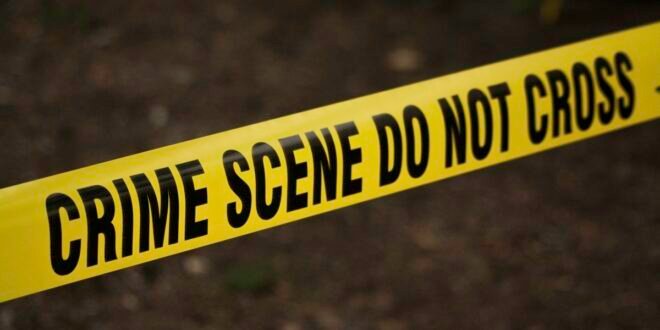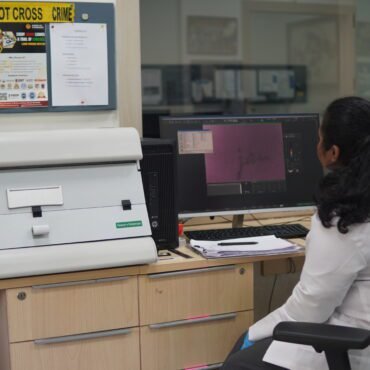Introduction to Crime Scene
“A crime scene refers to any specific physical area or site that could offer valuable evidence for investigation purposes. It may include a person’s body, any kind of building, automobiles, open-air sites, or anything found therein. As a result, “crime scene examination” refers to an investigation in which forensic or scientific techniques are employed to preserve and collect physical evidence of a crime.”
Fig. 1: Crime Scene Investigation
What is a crime scene investigation?
Crime Scene Investigation (CSI) is the systematic process of gathering, documenting, analyzing, and interpreting physical evidence found at a location where a crime has occurred. It involves the meticulous collection and examination of evidence to reconstruct the sequence of events, identify potential suspects, and establish the truth about what occurred.
Types of a crime scene
- Based on location
Indoor Crime Scenes: Crimes occurring within enclosed structures like houses, buildings, or vehicles. Investigations here focus on interior spaces and may involve various rooms or compartments.
Outdoor Crime Scenes: Crimes occurring in open areas such as streets, parks, alleys, or fields. Investigations cover exterior locations and evidence collection might involve large outdoor spaces.
Transitory Crime Scenes: Crimes that span both indoor and outdoor locations, requiring investigations in multiple areas. These scenes involve movement between indoor and outdoor spaces, leaving evidence in different environments.
Enclosed Crime Scenes: Crime scenes that are confined within a specific perimeter, often enclosed by physical boundaries like fences or barriers. Investigations focus on contained spaces with limited access points.
Conveyance Crime Scenes: These crime scenes involve criminal activities within or connected to vehicles like cars, boats, or planes.
- Based on the location of the crime committed
Primary crime scene: The primary crime scene is where the actual criminal activity took place. It is where the initial incident occurred, such as a murder, robbery, or assault. Investigators focus on collecting the most crucial evidence directly related to the crime. This location provides essential clues about what happened and who was involved.
Secondary crime scene: A secondary crime scene is a location related to the primary crime scene but not where the initial crime occurred. It might be a place where evidence, such as the victim’s belongings, the weapon used, or other significant items, was moved or discarded after the crime. Investigators gather evidence here that links back to the primary scene or helps establish connections between people, objects, or events.
- Based on the crime committed
Homicide Crime Scene: Locations where a person has been killed unlawfully. Investigations aim to collect evidence related to the victim, cause of death, and potential suspects.
Burglary/Theft Crime Scene: Areas where unlawful entry or theft of property has occurred. Investigations focus on gathering evidence related to forced entry, stolen items, or any damage caused.
Assault Crime Scene: Places where physical attacks or violence have occurred, leading to injuries. Evidence collection revolves around the scene of the argument and injuries sustained by victims.
Drug-Related Crime Scene: Locations involved in drug production, distribution, or consumption. Investigations target evidence such as narcotics, items, or substances related to drug offenses.
Sexual Assault Crime Scene: Areas where sexual offenses have taken place. Investigations prioritize evidence related to the assault, including DNA, physical trauma, or items linked to the perpetrator.
Arson Crime Scene: Sites affected by intentional fires set to cause damage. Investigations focus on determining the cause of the fire and collecting evidence related to accelerants or ignition points.
Macroscopic Crime Scene: The macroscopic crime scene can be a place where a crime has happened or the evidence related to the crime has been found.
Microscopic Crime Scene: The microscopic classification of the crime scene is more focused on the specific types of physical evidence found in the macroscopic crime scenes.
The primary objective of a crime scene investigation
The “7S” approach to crime scene investigation is a mnemonic used to emphasize key aspects that guide investigators in conducting a thorough and effective investigation. These “S” stand for different components and considerations integral to crime scene processing.
The first step involves securing and isolating the crime scene to prevent contamination, preserve evidence integrity, and ensure the safety of all personnel involved. Securing the scene helps maintain the chain of custody and prevents unauthorized access or tampering with evidence.
Fig. 2: Securing the crime scene with barricading tapes
- Separating the Witnesses:
Once the scene is secured, witnesses and individuals present at the scene are separated to prevent collusion (conspiracy between individuals or parties for deceitful or fraudulent purposes) or contamination of witness statements. Each witness is interviewed separately to gather independent and unbiased accounts of what they observed.
Ask them the following questions:
-Time of the crime?
-Who called in the crime?
-Who is the victim?
-What did they saw?
-Your location during the crime?
Investigators conduct a preliminary scan or walkthrough of the entire crime scene to identify and document potential evidence, patterns, or points of interest. This initial assessment helps in formulating an investigation strategy and prioritizing areas for detailed examination.
-Identify the primary scene: Where the crime is committed.
-Identify the secondary scene: Related to the primary scene that might have evidence related to crime.
This step involves a detailed and systematic examination of the crime scene. Investigators carefully observe and document everything visible, such as the layout, positioning of the items, and any potential evidence. This thorough examination includes taking photographs, sketches, and detailed notes.
-Photography: close-range, mid-range, far-range, visual, UV, IR photography.
-Videography
Fig. 3: Photographing the crime scene
Sketching the crime scene involves creating a detailed diagram or sketch that accurately represents the spatial relationships between objects, evidence, and relevant features within the scene. It complements photographic records and offers a visual portrayal for future examination.
A rough sketch is made with the position of every evidence and body mentioned from particular points/objects.
Every major object at the crime scene should be mentioned: tree, vehicle, etc.
Sketching methods:
-Cross projection
-Baseline
-Polar
-Rectangular
Investigators conduct a systematic and meticulous search for evidence, employing various techniques and tools to collect relevant items. Evidence can include physical objects, biological samples, fingerprints, or trace materials. Each piece of evidence is carefully documented and collected following proper protocols.
Methods used for searching:
-Grip
-Strip/line
-Spiral
-Triangular
-Quadrant/Zone
Fig. 4: Searching methods
- Securing and Collecting Evidence:
Once evidence is located, it is properly secured, collected, documented, and packaged using appropriate methods to preserve its integrity. Maintaining the chain of custody and ensuring proper handling and labeling is crucial throughout the collection and storage process.
Fig. 5: Evidence collection and preservation
These “7S” collectively serve as a guideline for crime scene investigators, emphasizing the essential steps and considerations required to methodically process a crime scene, gather evidence, and conduct a thorough investigation.
The Crime-Scene Investigation Team
A crime scene investigation team is comprised of various professionals with specialized skills and expertise, working collaboratively to conduct thorough and effective investigations. The team typically includes:
- Crime Scene Investigators (CSIs):
CSIs are specially trained law enforcement officers responsible for processing crime scenes. They collect, document, and analyze physical evidence, such as fingerprints, digital evidence, DNA, and trace materials. They also photograph, sketch, and preserve the crime scene.
Forensic scientists analyze the collected evidence in laboratories. They use scientific methods to examine fingerprints, DNA, ballistics, toxicology, and other forensic disciplines to provide expert analysis and interpretations that aid in investigations.
- Detectives/Investigators:
Detectives or investigators lead the overall investigation. They coordinate with CSIs, review evidence findings, interview witnesses, gather information, and develop theories to solve the case. Their role involves overseeing the investigation and ensuring all aspects are thoroughly explored.
- Medical Examiners/Coroners:
Medical examiners or coroners are responsible for determining the cause and manner of death in cases involving fatalities. They conduct autopsies, examine bodies, and provide insights into the nature of injuries or causes of death, which are critical in homicide investigations.
Forensic pathologists are medical doctors specializing in examining bodies and understanding the effects of injuries or diseases. They provide expertise in identifying injuries, determining the time of death, and assessing the significance of wounds or trauma.
Evidence technicians assist in the collection, preservation, and processing of evidence under the guidance of CSIs. They handle tools, maintain equipment, and ensure proper documentation and packaging of evidence.
- Digital Forensic Analysts:
In cases involving digital evidence (computers, laptops, phones, etc.), digital forensic analysts specialize in retrieving, preserving, and analyzing electronic data. They recover deleted files, trace online activities, and provide insights into digital evidence.
- Prosecutors and Legal Experts:
Prosecutors work closely with the investigation team, providing legal guidance and strategies for building cases based on collected evidence. They help determine the admissibility of evidence and prepare for legal proceedings.
Evidence samples that could potentially be collected from a crime scene
- Biological Samples: Blood, saliva, hair, semen, or bodily fluids for DNA identification.
- Trace Evidence: Fibers, glass fragments, soil, or vegetation etc. linking suspects to locations.
- Fingerprints and DNA: Latent fingerprints and DNA swabs from items for identification.
- Firearm Evidence: Bullets, cartridge casings, and gunshot residue for weapon identification.
- Digital evidence: Cell phones, laptops, computers, hard drives, pen drives, etc.
- Documents: Handwritten notes, suicide notes, financial documents, etc.
- Tool marks and Impressions: Marks from tools or tire impressions, footmarks linking suspects to actions.
- Fire and Arson Related Samples: Accelerants, and burn patterns for fire cause determination.
- Drug evidence
These samples provide crucial evidence in solving crimes and require careful collection, documentation, and preservation for forensic analysis and investigation.
Crime scene investigation kit: essential components
A crime scene investigation (CSI) kit comprises essential components that aid in collecting, preserving, and documenting evidence crucial to investigations. Some fundamental components of a CSI kit include
- Personal Protection (PPE) Kits
Safety comes first. A CSI kit typically includes:
Gloves: Latex or nitrile gloves to avoid contamination.
Masks, Hair covering, and Goggles: To prevent inhalation of harmful substances or contact with fluids.
Booties/Coveralls: To prevent cross-contamination and trace evidence transfer.
Accurate documentation is vital for reconstructing the scene. The kit might contain:
Notebooks, Pens, and Markers: For noting observations, timestamps, and sketches of the scene.
Camera and Accessories: To capture high-resolution images of the scene from various angles.
Measuring Tapes/Rulers: For accurately measuring distances between evidence.
This category covers tools used to gather physical evidence:
Sterile Swabs and Collection Jars: To collect biological samples or trace evidence.
Bindle paper: For collecting trace evidence.
Evidence Bags/Containers: To store evidence while preserving its integrity.
Fingerprint Kits: Includes powders, brushes, and lifting tapes for recovering prints.
Evidence markers: Used to mark and illustrate items of evidence at a crime scene.
These tools aid in the analysis and processing of evidence:
Forensic Light Source (UV & IR): For revealing hidden evidence like body fluids, fibres, or fingerprints.
Alternate Light Source (ALS): To detect fluorescence in substances like bodily fluids.
Chemical Reagents: Such as luminol for detecting blood traces.
Ensuring evidence integrity during transport and storage is crucial:
Sealable Bags/Containers: To prevent contamination or tampering during transit.
Cooling Packs/Containers: For preserving biological samples like blood or tissues.
Depending on the complexity of the investigation, specialized tools might be included:
Laser Scanners: For creating 3D models of the crime scene.
Gas Chromatography-Mass Spectrometry (GC-MS): Analyses volatile substances.
Digital Forensic Tools: To recover data from electronic devices.
Additional tools that aid in various aspects of investigation:
Tweezers/Forceps: For handling delicate evidence.
Scissors and Cutting Tools: To access and collect specific items.
Markers/Labels: To label evidence accurately.
Metal detectors: To help locate potential evidence like weapons, bullets, or knives. These tools aid forensic investigators in finding hidden or buried items relevant to a crime, assisting in evidence collection, and reconstructing events.
Compass/Directional markers
Magnifying glass
Presumptive blood test supplies
Sexual assault evidence collection kit
Nail clippers/ Orange peeler: Used to collect debris under suspected fingernails.
Cutting instruments (Knives, box cutters, scalpel, scissors)
Biohazard Bags: Used to collect and transport evidence from a crime or accident scene to another site, such as the laboratory.
Plastic resealable bags: Transporting and storing a variety of types of police exhibits.
Challenges that are encountered in Crime Scene Investigation Kits
Crime scene investigation kits are fundamental tools for law enforcement personnel and forensic experts. However, they also come with several challenges that can impact their effectiveness and the overall investigative process:
Standardization and Variability:
Crime scene investigation kits can vary in contents and quality across different agencies or jurisdictions. Standardization issues may arise, leading to inconsistencies in equipment, which can affect the thoroughness of investigations.
Limited Resources and Budget Constraints:
Some agencies may face budget constraints, affecting their ability to acquire advanced or updated equipment for their CSI kits. This could lead to outdated or insufficient tools, hindering the collection and analysis of evidence.
Technological Advancements:
Emerging forensic technologies may outpace the contents of standard CSI kits. Keeping up with new advancements in forensic tools and techniques requires regular updates, which might pose a challenge to agencies with limited resources.
Quality Control and Maintenance:
Equipment in CSI kits, such as cameras, alternate light sources, or fingerprinting tools, require regular maintenance and calibration. Lack of proper upkeep might result in malfunctioning or inaccurate readings, impacting evidence collection.
Training and Expertise:
Adequate training is crucial for using CSI kit components effectively. Limited training opportunities or insufficient expertise among personnel may lead to improper handling of evidence, reducing its reliability in court.
Storage and Preservation:
Proper storage conditions: Some evidence collection materials, especially those for biological samples or chemical tests, require specific storage conditions to maintain integrity. Inadequate storage might lead to degradation or contamination of evidence.
Legal and Procedural Challenges:
Challenges might arise in courts regarding the admissibility of evidence collected using certain tools or techniques from CSI kits, especially if their reliability or accuracy is questioned by defense attorneys.
Conclusion
Crime scene investigation (CSI) is a meticulous process fundamental to solving crimes. It encompasses securing the scene, methodically collecting evidence, and analyzing findings to reconstruct events. Collaboration among multidisciplinary experts (crime scene investigators, forensic scientists, and detectives) is paramount. Challenges like limited resources and rapidly evolving technologies pose hurdles, necessitating continual adaptation within the field.
Maintaining the utmost professionalism, accuracy, and strict adherence to protocols is essential throughout the investigative process. Proper evidence handling and preservation ensure the reliability of findings in legal proceedings. Despite challenges, CSI serves as the basis of criminal investigations, providing critical evidence essential for identifying perpetrators and delivering justice.
The commitment to ongoing training, utilization of advanced tools, and ethical practices enhance the effectiveness and credibility of crime scene investigations. Ultimately, CSI plays an important role in both solving crimes and offering closure to victims and their families, cementing its significance in upholding the integrity of the legal system.
Explore the Unparalleled Innovation of Hawk Eye Forensic’s CSI Kit
Our advanced crime scene investigation (CSI) kit redefines the norms, setting a new standard in forensic tools. Unlike conventional kits, our CSI kit embodies technological advancements and specialized functionalities that elevate forensic investigations to unparalleled heights.
Fig. 6: Hawk Eye Forensic’s Crime Scene Investigation Kit
- Latest Technology: Our kits integrate advanced fingerprint detection, high-resolution imaging, and specialized evidence-collection tools. These technologically impressive items beat traditional CSI kits, ensuring precision and accuracy in evidence gathering.
- Easy to Use: Designed for usability, our kits feature user-friendly interfaces and streamlined functionalities. Investigators navigate crime scenes with ease, simplifying the complex task of evidence collection and preservation.
- Excellent Quality: We prioritize quality, durability, and standardization in every component. Our kits are adaptable, allowing customization based on diverse crime scene requirements and emerging forensic methodologies.
- Complete assistance and Training programs: We go beyond tools. We offer training programs, empowering law enforcement agencies and forensic professionals to maximize the kit’s potential effectively.
- Fully equipped for investigative purposes: our kits are meticulously assembled to offer a complete range of tools essential for conducting thorough investigations.
- Effortless Order Placement: At Hawk Eye Forensic, we prioritize your convenience. Enjoy secure payment options and speedy delivery to your doorstep, ensuring that you receive your investigative tools promptly.
- Rapid Shipping Services: Our fast delivery service aims to get your tools into your hands as fast as possible.
- PAN India Delivery: Our pan India delivery service aims to make forensic tools accessible to all investigative professionals, law enforcement agencies, and enthusiasts across the nation. Place your order with us and experience hassle-free nationwide delivery.
Discover the future of crime scene investigation with Hawk Eye Forensic. Explore our revolutionary CSI kit and witness the difference. Join us in reshaping the landscape of forensic investigations and advancing the pursuit of justice. https://hawkeyeforensic.com/index.php/crime-scene-investigation-kit/
References
- Technical Working Group on Crime Scene Investigation (2000). A Guide for Law Enforcement A Guide for Law Enforcement Crime Scene Investigation Crime Scene Investigation. [online] Available at: https://www.ojp.gov/pdffiles1/nij/178280.pdf.











Post comments (0)